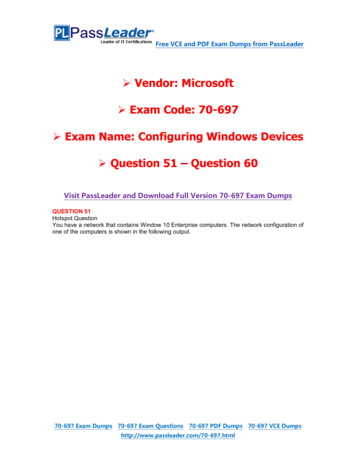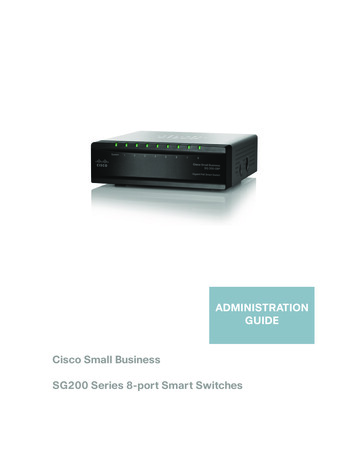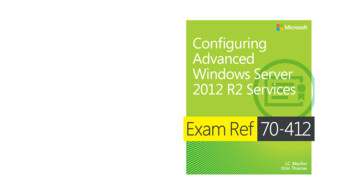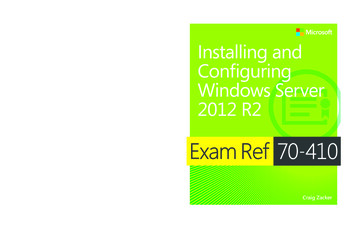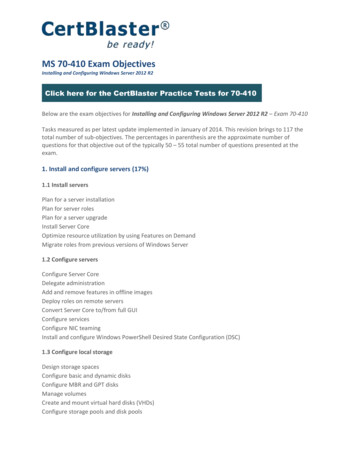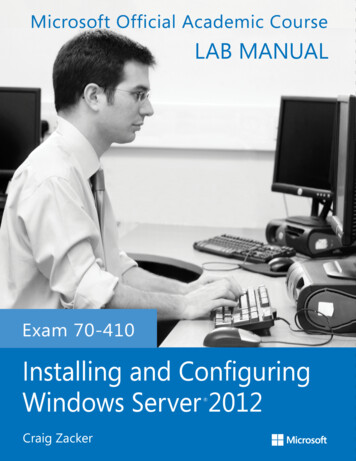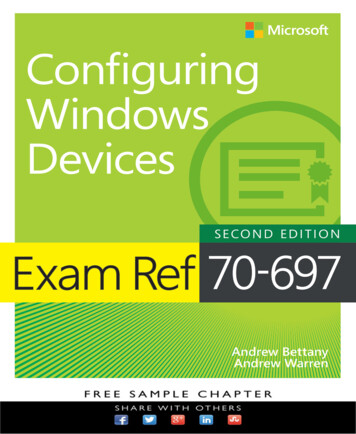
Transcription
Exam Ref 70-697Configuring WindowsDevicesSecond EditionAndrew BettanyAndrew Warren
Exam Ref 70-697 Configuring Windows Devices, Second EditionPublished with the authorization of Microsoft Corporation by:Pearson Education, Inc.Copyright 2018 by Pearson EducationAll rights reserved. Printed in the United States of America. This publication is protected by copyright, and permission mustbe obtained from the publisher prior to any prohibited reproduction, storage in a retrieval system, or transmission in anyform or by any means, electronic, mechanical, photocopying, recording, or likewise. For information regarding permissions,request forms, and the appropriate contacts within the Pearson Education Global Rights & Permissions Department, please visitwww.pearsoned.com/permissions/. No patent liability is assumed with respect to the use of the information contained herein.Although every precaution has been taken in the preparation of this book, the publisher and author assume no responsibility forerrors or omissions. Nor is any liability assumed for damages resulting from the use of the information contained herein.ISBN-13: 978-1-5093-0785-2ISBN-10: 1-5093-0785-0Library of Congress Control Number: 20189384851 18TrademarksMicrosoft and the trademarks listed at https://www.microsoft.com on the “Trademarks” webpage are trademarks of theMicrosoft group of companies. All other marks are property of their respective owners.Warning and DisclaimerEvery effort has been made to make this book as complete and as accurate as possible, but no warranty or fitness is implied.The information provided is on an “as is” basis. The authors, the publisher, and Microsoft Corporation shall have neitherliability nor responsibility to any person or entity with respect to any loss or damages arising from the information containedin this book or programs accompanying it.Special SalesFor information about buying this title in bulk quantities, or for special sales opportunities (which may include electronicversions; custom cover designs; and content particular to your business, training goals, marketing focus, or brandinginterests), please contact our corporate sales department at corpsales@pearsoned.com or (800) 382-3419.For government sales inquiries, please contact governmentsales@pearsoned.com.For questions about sales outside the U.S., please contact intlcs@pearson.com.Editor-in-ChiefGreg WiegandSenior EditorTrina MacDonaldDevelopment EditorMark RenfrowManaging EditorSandra SchroederSenior Project EditorTracey CroomEditorial ProductionBackstop MediaCopy EditorChristina RudloffIndexerJulie GradyProofreaderTroy MottTechnical EditorByron WrightCover DesignerTwist Creative, Seattle
I would like to dedicate this book to Annette and Tommy, for beingso supportive and encouraging whenever I work on projects thatsometimes eat into our quality time together. This book is also forthe reader–having taught thousands of IT Professionals over mycareer, I hope this book reaches a greater audience and helps youachieve your career aspirations. Work hard and aim for the stars!.—Andrew BettanyWriting this book has been a team effort, and I am delighted tohave been a part of that team. Aside from the folks at Pearson andmy co-author, Andrew, I’d like to mention my dog, Lucy. Her enthusiasm for long walks undoubtedly helped me clear my head, andthus to deliver chapters on time to our editor, Trina Macdonald.—Andrew Warren
Contents at a glanceIntroductionxviiImportant: How to use this book to study for the examxxiCHAPTER 1Manage Identity1CHAPTER 2Plan desktop and device deployment37CHAPTER 3Plan and implement a Microsoft 365 solution73CHAPTER 4Configure networking133CHAPTER 5Configure storage163CHAPTER 6Manage data access and protection207CHAPTER 7Manage remote access261CHAPTER 8Manage apps307CHAPTER 9Manage updates and recovery337Index389
ContentsIntroductionxviiOrganization of this book. . . . . . . . . . . . . . . . . . . . . . . . . . . . . . . . . . . . . . . . . . . . xviiiMicrosoft certifications . . . . . . . . . . . . . . . . . . . . . . . . . . . . . . . . . . . . . . . . . . . . . . xviiiMicrosoft Virtual Academy. . . . . . . . . . . . . . . . . . . . . . . . . . . . . . . . . . . . . . . . . . . xviiiQuick access to online references. . . . . . . . . . . . . . . . . . . . . . . . . . . . . . . . . . . . . xviiiErrata, updates, & book support. . . . . . . . . . . . . . . . . . . . . . . . . . . . . . . . . . . . . . . xixStay in touch. . . . . . . . . . . . . . . . . . . . . . . . . . . . . . . . . . . . . . . . . . . . . . . . . . . . . . . . . xixImportant: How to use this book to study for the examChapter 1Manage Identityxxi1Skill 1.1: Support Microsoft Store, Microsoft Store for Education,Microsoft Store for Business, and cloud apps. . . . . . . . . . . . . . . . . . . . . . . . . . 1Integrate Microsoft account and personalization settings2Install and manage software5Sideload apps into offline and online images11Sideload apps by using Microsoft Intune14Deep link apps using Microsoft Intune17Skill 1.2: Support authentication and authorization. . . . . . . . . . . . . . . . . . . . . . 18Support user authentication19Support workgroup, homegroup, and domain membership23Configure local accounts and Microsoft accounts29Configure Workplace Join30Configure Azure AD Join30Configure Windows Hello33Thought experiments. . . . . . . . . . . . . . . . . . . . . . . . . . . . . . . . . . . . . . . . . . . . . 34Scenario 134Scenario 234vii
Thought experiment answers . . . . . . . . . . . . . . . . . . . . . . . . . . . . . . . . . . . . . . . . . . 35Scenario 135Scenario 235Chapter summary . . . . . . . . . . . . . . . . . . . . . . . . . . . . . . . . . . . . . . . . . . . . . . . . . . . . . 35Chapter 2Plan desktop and device deployment37Skill 2.1: Migrate and configure user data. . . . . . . . . . . . . . . . . . . . . . . . . . . . . . . . 37Configure user profiles38Configure folder location40Migrate user profiles41Skill 2.2: Configure Hyper-V. . . . . . . . . . . . . . . . . . . . . . . . . . . . . . . . . . . . . . . . . . . . 43Create and configure virtual machines44Create and manage checkpoints48Create and configure virtual switches49Create and configure virtual disks50Move virtual machine storage51Skill 2.3: Configure mobility options. . . . . . . . . . . . . . . . . . . . . . . . . . . . . . . . . . . . 52Configure offline file policies53Configure sync options55Managing Power Settings56Configure Windows To Go60Configure Wi-Fi Direct63Skill 2.4: Configure security for mobile devices. . . . . . . . . . . . . . . . . . . . . . . . . . 63Configure BitLocker64Configure startup key storage67Thought experiments. . . . . . . . . . . . . . . . . . . . . . . . . . . . . . . . . . . . . . . . . . . . . . . . . . 68Scenario 168Scenario 268Scenario 369Scenario 469Thought experiment answers . . . . . . . . . . . . . . . . . . . . . . . . . . . . . . . . . . . . . . . . . . 70viiiContentsScenario 170Scenario 270
Scenario 370Scenario 470Chapter summary . . . . . . . . . . . . . . . . . . . . . . . . . . . . . . . . . . . . . . . . . . . . . . . . . . . . . 71Chapter 3Plan and implement a Microsoft 365 solution73Skill 3.1: Support mobile devices. . . . . . . . . . . . . . . . . . . . . . . . . . . . . . . . . . . . . . . . 73Support mobile device policies74Support mobile access and data synchronization79Support broadband connectivity82Support Mobile Device Management by using Microsoft Intune84Skill 3.2: Deploy software by using Microsoft Intune. . . . . . . . . . . . . . . . . . . . . 88Use reports and In-Console Monitoring to identifyrequired updates89Approve or decline updates91Configure automatic approval settings92Configure deadlines for update installations93Deploy third-party updates93Skill 3.3: Manage devices with Microsoft 365 Solution . . . . . . . . . . . . . . . . . . 94Provision user accounts95Enroll devices into Microsoft 365 Business97Enroll devices into Microsoft 365 Enterprise99View and manage all managed devices100Configure Microsoft Intune subscriptions102Configure the Microsoft Service Connection Point role103Manage user and computer groups104Configure monitoring and alerts106Troubleshoot Microsoft Intune109Manage policies110Manage remote computers112Skill 3.4: Configure information protection. . . . . . . . . . . . . . . . . . . . . . . . . . . . . 113Manage and configure Office 365 Data Loss Prevention114Windows Information Protection and BitLocker117Azure Information Protection120Microsoft Cloud App Security123Contentsix
Explore Microsoft Cloud App Security124Office 365 Cloud App Security126Thought experiments. . . . . . . . . . . . . . . . . . . . . . . . . . . . . . . . . . . . . . . . . . . . . . . . . 128Scenario 1128Scenario 2128Scenario 3128Scenario 4129Thought experiment answer . . . . . . . . . . . . . . . . . . . . . . . . . . . . . . . . . . . . . . . . . . 129Scenario 1129Scenario 2129Scenario 3129Scenario 4130Chapter summary . . . . . . . . . . . . . . . . . . . . . . . . . . . . . . . . . . . . . . . . . . . . . . . . . . . . 130Chapter 4Configure networking133Skill 4.1: Configure IP settings. . . . . . . . . . . . . . . . . . . . . . . . . . . . . . . . . . . . . . . . . . 133Connect to a network133Configure name resolution139Configure network locations141Skill 4.2: Configure network settings. . . . . . . . . . . . . . . . . . . . . . . . . . . . . . . . . . . 143Connect to a wireless network143Manage preferred wireless networks144Configure network adapters145Configure location-aware printing146Skill 4.3: Configure and maintain network security. . . . . . . . . . . . . . . . . . . . . . 147xContentsWindows Defender Security Center148Configure Windows Firewall149Configure Windows Firewall with Advanced Security152Configure connection security rules with IPsec155Configure authentication exceptions156Configure network discovery157
Thought experiments. . . . . . . . . . . . . . . . . . . . . . . . . . . . . . . . . . . . . . . . . . . . . . . . . 158Scenario 1158Scenario 2159Scenario 3159Thought experiment answers . . . . . . . . . . . . . . . . . . . . . . . . . . . . . . . . . . . . . . . . . 159Scenario 1159Scenario 2160Scenario 3160Chapter summary . . . . . . . . . . . . . . . . . . . . . . . . . . . . . . . . . . . . . . . . . . . . . . . . . . . . 160Chapter 5Configure storage163Skill 5.1: Support data storage. . . . . . . . . . . . . . . . . . . . . . . . . . . . . . . . . . . . . . . . . 163Distributed File System164Support Storage Spaces167Manage Storage Spaces using PowerShell173Support OneDrive174Skill 5.2: Support data security . . . . . . . . . . . . . . . . . . . . . . . . . . . . . . . . . . . . . . . . 179Manage permissions including Sharing, NTFS andDynamic Access Control179Support Encrypting File System185Troubleshoot Encrypting File System186Controlling access to removable media187Support BitLocker and BitLocker To Go188Configure BitLocker using command-line tools194Understand Microsoft BitLocker Administrationand Monitoring200Thought experiments. . . . . . . . . . . . . . . . . . . . . . . . . . . . . . . . . . . . . . . . . . . . . . . . 203Scenario 1203Scenario 2203Thought experiment answers . . . . . . . . . . . . . . . . . . . . . . . . . . . . . . . . . . . . . . . . 204Scenario 1204Scenario 2204Chapter summary . . . . . . . . . . . . . . . . . . . . . . . . . . . . . . . . . . . . . . . . . . . . . . . . . . . 204Contentsxi
Chapter 6Manage data access and protection207Skill 6.1: Configure shared resources . . . . . . . . . . . . . . . . . . . . . . . . . . . . . . . . . . 207Configure HomeGroup settings208Configure libraries210Configure shared folder permissions213Configure shared printers219Configure OneDrive224Co-existence of OneDrive and OneDrive for Business229Skill 6.2: Configure file and folder access. . . . . . . . . . . . . . . . . . . . . . . . . . . . . . 232Encrypt files and folders by using Encrypting File System233Configure NTFS permissions237Configure disk quotas245Configure file access auditing247Configure authentication and authorization250Thought experiments. . . . . . . . . . . . . . . . . . . . . . . . . . . . . . . . . . . . . . . . . . . . . . . . 256Scenario 1256Scenario 2256Thought experiment answers . . . . . . . . . . . . . . . . . . . . . . . . . . . . . . . . . . . . . . . . 257Scenario 1257Scenario 2257Chapter summary . . . . . . . . . . . . . . . . . . . . . . . . . . . . . . . . . . . . . . . . . . . . . . . . . . . 258Chapter 7Manage remote access261Skill 7.1: Configure remote connections . . . . . . . . . . . . . . . . . . . . . . . . . . . . . . . . 261xiiContentsConfigure remote authentication262Configure VPN connections and authentication262Enable VPN Reconnect268Configure broadband tethering269Configure Remote Desktop client for Windows 10 Mobile,iOS, and Android272Configure Remote Desktop settings275Enable restricted admin mode for RDP in Windows 8.1and Windows 2012 R2277Remote Desktop Connection Zoom support280
Skill 7.2: Configure mobility options . . . . . . . . . . . . . . . . . . . . . . . . . . . . . . . . . . . 281Configure offline file policies282Configure power policies285Configure Windows To Go290Configure sync options294Configure WiFi Direct300Thought experiments. . . . . . . . . . . . . . . . . . . . . . . . . . . . . . . . . . . . . . . . . . . . . . . . 302Scenario 1302Scenario 2303Thought experiment answers . . . . . . . . . . . . . . . . . . . . . . . . . . . . . . . . . . . . . . . . 303Scenario 1303Scenario 2304Chapter summary . . . . . . . . . . . . . . . . . . . . . . . . . . . . . . . . . . . . . . . . . . . . . . . . . . . 304Chapter 8Manage apps307Skill 8.1: Deploy and manage RemoteApp apps. . . . . . . . . . . . . . . . . . . . . . . . 307Configure RemoteApp prerequisites308Configure RemoteApp and Desktop Connections settings313Configure Group Policy Objects for signed packages316Subscribe to the Desktop Connections feeds317Support iOS and Android317Configure Remote Desktop Web access for distribution318Skill 8.2: Support desktop apps. . . . . . . . . . . . . . . . . . . . . . . . . . . . . . . . . . . . . . . . 319Support desktop app compatibility by usingApplication Compatibility Tools320Support desktop application co-existence324Install and configure User Experience Virtualization330Deploy desktop apps by using Microsoft Intune331Thought experiments. . . . . . . . . . . . . . . . . . . . . . . . . . . . . . . . . . . . . . . . . . . . 333Scenario 1333Scenario 2334Contentsxiii
Thought experiment answers . . . . . . . . . . . . . . . . . . . . . . . . . . . . . . . . . . . . . . . . 334Scenario 1334Scenario 2334Chapter summary . . . . . . . . . . . . . . . . . . . . . . . . . . . . . . . . . . . . . . . . . . . . . . . . . . . 334Chapter 9Manage updates and recovery337Skill 9.1: Configure system recovery. . . . . . . . . . . . . . . . . . . . . . . . . . . . . . . . . . . 337Configure a recovery drive338Configure system restore340Perform a reset347Perform a Fresh Start349Perform a driver rollback351Configure restore points353Skill 9.2: Configure file recovery. . . . . . . . . . . . . . . . . . . . . . . . . . . . . . . . . . . . . . 357Configure File History358Restore previous versions of files and folders361Recover files from OneDrive363Skill 9.3: Configure and manage updates. . . . . . . . . . . . . . . . . . . . . . . . . . . . . . 365Configure update settings366Configure Windows Update policies373Manage update history377Roll back updates378Update Microsoft Store apps382Thought experiments. . . . . . . . . . . . . . . . . . . . . . . . . . . . . . . . . . . . . . . . . . . . . . . . 385Scenario 1385Scenario 2385Scenario 3386Thought experiment answers . . . . . . . . . . . . . . . . . . . . . . . . . . . . . . . . . . . . . . . . 386Scenario 1386Scenario 2386Scenario 3387Chapter summary . . . . . . . . . . . . . . . . . . . . . . . . . . . . . . . . . . . . . . . . . . . . . . . . . . . 387IndexxivContents389
About the authorsANDREW BETTANY, Microsoft Most Valuable Professional (Windows andDevices for IT), Dad, IT Geek, training mentor and consultant, entrepreneur, and author.As a Microsoft Most Valuable Professional (MVP), Andrew is recognized forhis Windows expertise, and is the author of several publications, includingWindows exam certification prep, Microsoft official training materials, and anauthor of video training materials for LinkedIn Learning and Pluralsight.Having managed the IT Academy at the University of York, UK for years, he now focuses histime training and writing. As a Microsoft Certified Trainer, Andrew delivers learning and consultancy to businesses on many technical areas including Microsoft 365, Azure, and Windows.He has co-founded the “IT Masterclasses” series of short intensive technical courses, www.itmasterclasses.com, and is passionate about helping others learn technology. He is a frequentspeaker and proctor at Microsoft Ignite conferences worldwide.Active on social media, Andrew can be found on LinkedIn Facebook and Twitter. He lives in avillage just outside of the beautiful city of York in Yorkshire (UK).ANDREW WARREN has over 30 years of experience in IT and has served assubject matter expert for many Microsoft Official Curriculum courses. Heis a Microsoft Certified Trainer and runs his own training consultancy inthe UK.
IntroductionThe Configuring Windows Devices exam (70-697) is separated into nine sets ofobjectives.This book contains nine chapters that clearly detail what those objectives are and thecontent that you can expect to see on the exam. Because each chapter covers a part of theexam, you should concentrate on one chapter at a time and complete the thought experimentsand review questions. This book covers the general, high-level knowledge you need to knowto answer questions regarding why and when you might perform tasks relating to the examobjectives.Prior to taking the certification exam, you should fully prepare to the best of your abilityand we assume that you have some practical experience supporting Windows devices withinthe workplace. You are also probably reading this book as part of your final preparations andthat you feel almost ready to take the exam. In this book we have included how-to steps andwalkthroughs whenever we feel that they are useful, and we hope that you will perform thetasks on your system or within a virtual machine to crystalize your knowledge. Throughout thebook there are numerous notes and links to resources on the Internet, which should add evenmore depth to your preparation. You should expect that Windows 10 will evolve constantly,through Windows upgrades, and you should always supplement your learning with practicalexperience obtained by using the latest build of the operating system because there are alwaysnew things to learn and fresh challenges to master.This book covers every major topic area found on the exam, but it does not cover everyexam question. Only the Microsoft exam team has access to the exam questions, andMicrosoft regularly adds new questions to the exam, making it impossible to cover specificquestions. You should consider this book a supplement to your relevant real-world experienceand other study materials. If you encounter a topic in this book that you do not feel completely comfortable with, use the “Need more review?” links you’ll find in the text to find moreinformation and take the time to research and study the topic. Great information is availableon https://docs.microsoft.com and in blogs and forums.Introduction xvii
Organization of this bookThis book is organized by the “Skills measured” list published for the exam. The “Skills measured” list is available for each exam on the Microsoft Learning website: http://aka.ms/examlist.Each chapter in this book corresponds to a major topic area in the list, and the technical tasksin each topic area determine a chapter’s organization. If an exam covers six major topic areas,for example, the book will contain six chapters.Microsoft certificationsMicrosoft certifications distinguish you by proving your command of a broad set of skills andexperience with current Microsoft products and technologies. The exams and correspondingcertifications are developed to validate your mastery of critical competencies as you designand develop, or implement and support, solutions with Microsoft products and technologiesboth on-premises and in the cloud. Certification brings a variety of benefits to the individualand to employers and organizations.MORE INFOALL MICROSOFT CERTIFICATIONSFor information about Microsoft certifications, including a full list of available certifications,go to http://www.microsoft.com/learning.Microsoft Virtual AcademyBuild your knowledge of Microsoft technologies with free expert-led online training from Microsoft Virtual Academy (MVA). MVA offers a comprehensive library of videos, live events, andmore to help you learn the latest technologies and prepare for certification exams. You’ll findwhat you need here:http://www.microsoftvirtualacademy.comxviii Introduction
Errata, updates, & book supportWe’ve made every effort to ensure the accuracy of this book and its companion content. Youcan access updates to this book—in the form of a list of submitted errata and their d2/errataIf you discover an error that is not already listed, please submit it to us at the same page.If you need additional support, email Microsoft Press Book Support atmspinput@microsoft.com.Please note that product support for Microsoft software and hardware is not offeredthrough the previous addresses. For help with Microsoft software or hardware, go to http://support.microsoft.com.Stay in touchLet’s keep the conversation going! We’re on Twitter: http://twitter.com/MicrosoftPress.Introduction xix
Important: How to use this book to study for the examCertification exams validate your on-the-job experience and product knowledge. To gaugeyour readiness to take an exam, use this Exam Ref to help you check your understanding of theskills tested by the exam. Determine the topics you know well and the areas in which you needmore experience. To help you refresh your skills in specific areas, we have also provided “Needmore review?” pointers, which direct you to more in-depth information outside the book.The Exam Ref is not a substitute for hands-on experience. This book is not designed to teachyou new skills.We recommend that you round out your exam preparation by using a combination of available study materials and courses. Learn more about available classroom training athttp://www.microsoft.com/learning. Microsoft Official Practice Tests are available for manyexams at http://aka.ms/practicetests. You can also find free online courses and live events fromMicrosoft Virtual Academy at http://www.microsoftvirtualacademy.com.This book is organized by the “Skills measured” list published for the exam. The“Skills measured” list for each exam is available on the Microsoft Learning website:http://aka.ms/examlist.Note that this Exam Ref is based on this publicly available information and the author’sexperience. To safeguard the integrity of the exam, authors do not have access to the examquestions.Introduction xxi
CHAPTER 4Configure networkingIt is important to understand the fundamentals of networking in Windows 10 to pass the70-697, Configuring Windows Devices exam. Network connectivity is an almost universalassumption in typical Windows 10 operation, so understanding how Windows networkingworks will help you in many areas of the exam. This chapter will cover the basics of main networking components of Windows 10, along with how to configure each of them.Skills in this chapter: Skill 4.1: Configure IP settings Skill 4.2: Configure network settings Skill 4.3: Configure and maintain network securitySkill 4.1: Configure IP settingsThe IP address is the most widely used point of contact for a Windows 10 computer that isconnected to the network. A computer’s IP address uniquely identifies it on the local networksegment, and it serves as the functional component for most of the ways that computerscommunicate on a network, including name resolution and file transfer.This section covers how to: Connect to a network Configure name resolution Configure network locationsConnect to a networkNetworks are groups of computers and other resources. When connected, each resource thatis connected (computer, network printer, server, or other host) must acquire, or have previously been assigned an exclusive address that will define it on that network. These addressesare unique, and you can’t have two hosts on the same network with the same address. Thismakes addressing a very important part of configuring and connecting to networks.133
Understanding IP address requirementsEach host on a network must have a unique Internet Protocol (IP) address. This address, whenit’s configured as an IPv4 address, is a 32-bit number that is styled as four sets of decimal numbers. For example: 192.168.4.20. Each host is also assigned a subnet mask, which determineswhich part of the IP address defines the network and which part defines the host. Together,the IP address and the subnet mask define the network within which a host can communicate.If the host requires communication outside of the local network segment, a gateway must bespecified, which typically represents a network router that can provide network paths to othernetworks and the Internet. The IP address, subnet mask and default gateway together providethe full definition of IP connectivity for a network host. There are two ways to get an address toa resource: You can define it manually, or it can be assigned by a Dynamic Host ConfigurationProtocol (DHCP) server.When an address can’t be assigned this way, Windows will assign its own IP address using a technology called Automatic Private IP Addressing (APIPA). APIPA addresses fall in the169.254.x.x address range.EXAM TIPMake sure to review the IP address ranges for Class A, B, and C to have an idea of how manynetworks and hosts each offers. Know their default subnet masks, too. Beyond that, knowthe private addresses available for local networks (192.x.x.x, 172.x.x.x, and 10.x.x.x for ClassC, B, and A, respectively).Understanding network terminologyMake sure that you are familiar with the following terms before continuing: 134Chapter 4APIPA This is a link-local (IP) address that is assigned by Windows when no otheraddressing mechanism can be found. This enables the host to function on the local network segment. Routers do not forward packets from these kinds of addresses.Default gateway This hardware or software device lets hosts connect to other networks. Often that network is the Internet, but it could also be another network segmentin an enterprise domain.DHCP This is a networking protocol that dynamically configures IP addresses for hostson a network. A DHCP server assigns these addresses. These IP addresses are generallygranted for a specified interval and must be renewed when the interval is up. If specificstatic addresses are required for clients, DHCP can be configured to allow reservationsfor those clients.DHCP Scope A DHCP scope is a consecutive range of possible IP addresses that canbe offered to hosts on a subnet (part of a network).Configure networking
DNS Domain Name Service (DNS) is a service that enables users to type the nameof the host to which they want to connect to instead of its IP address. A DNS serverresolves the name.IPv4 This is an IP address that consists of 32 bits, notated by four 8-bit octets. It hastwo parts: the network ID and the host ID. The network ID describes the network, andthe host ID defines the specific device on it. IPv4 addresses can be Unicast, Broadcast, orMulticast.Subnet mask This 32-bit number, notated by four 8-bit octets that consist of a set of1s followed by a set of 0s, is used to define which part of the IPv4 address is the networkID and which part is the host ID. The 1s denote the network; the 0s denote the host.The default subnet masks are in the form 255.0.0.0 for Class A addresses, 255.255.0.0for Class B addresses, and 255.255.255.0 for Class C addresses. Translated to binary,255.0.0.0 looks like this: 11111111 00000000 00000000 00000000.IPv6 The available IPv4 address combinations are dwindling, thus the need for a better option. IPv6 is that option. Instead of a 32-bit space, it’s a 128-bit space with 16-bitboundaries. This allows for many more addresses. An IPv6 address typically looks likethis: 21DA:D3:0:2F3B:2AA:FF:FE28:9C5A.MORE INFO IP ADDRESSINGFor more information on how IP addresses are defined and how they function, visit: 29.aspx.Configuring IP settingsYou can configure IP settings on a Windows 10 computer by accessing the Properties page forthe network adapter. To open the Properties page, perform the following steps:1.From the desktop, right-click the Start button, and then click Network Connections.2.In Settings, click Change Adapter Options.3.In the Network Connections window, shown in Figure 4-1, right-click the appropriatenetwork adapter, and then click Properties.Skill 4.1: Configure IP settingsChapter 4135
FIGURE 4-1 Configuring network connections4.In the Ethernet Properties dialog box shown in Figure 4-2, select Internet Protocol Version 4 (TCP/IP4), and then click Properties.FIGURE 4-2 Configuring a network connection’s properties136Chapter 4Configure networking
5.In the Internet Protocol Version 4 Properties dialog box shown in Figure 4-3, select theappropriate configuration options and specify addresses, if necessary. You can chooseto either obtain the IP address and DNS ser
Exam Ref 70-697 Configuring Windows Devices, Second Edition Published with the authorization of Microsoft Corporation by: Pearson Education, Inc.
